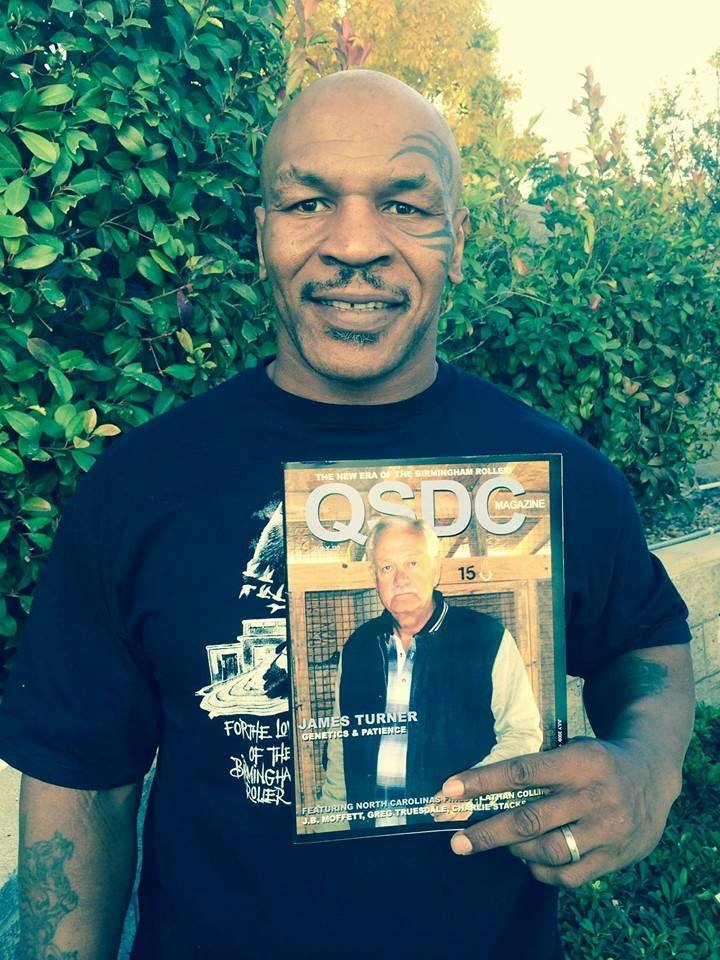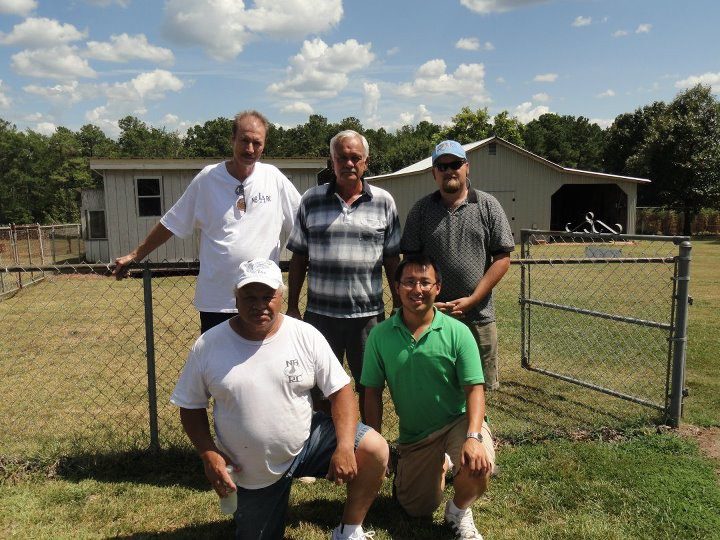
James Turner: The Man Who Put Color Into Spin
By Cliff Ball
The Carolinas are home to many great roller men. Names like Clay Hoyle, Joe Bob
Stuka, Jay Yandle, Bob Simpson, Wendall Carter, John Castro, Don Simpson, Don
Greene, Larry Williams, Bob Welbourne, Ed Garett, Tony Roberts, and James
Turner are all synonymous with competence in breeding quality, depth, speed,
frequency and kitting ability in performing rollers. But most importantly,
these names are synonymous with competition, with winning, with judging, and
with support and commitment to the NBRC
William H. Pensom once made the statement, “…a breeder can begin to understand the roller after nearly thirty years of experience.” No doubt Pensom was including himself in making that statement. There is also no doubt that James Turner qualifies to be named in that elite group of roller men, as well. Pensom also said, “It is also true that the fancier who has the most knowledge, breeds more of the best rollers.”
James Turner’s knowledge of genetics and the roll gene far surpasses that of all but a few men. “He knows more about the inheritance of roll than anyone we know, and from practical experience,” says Clay Hoyle, one of North Carolina’s veteran breeders and competitors. Turner has, over the past forty-five years, amassed a wealth of knowledge in the area of the breeding and training of the performing roller pigeon.
Not always has he bred competition rollers. Throughout his life he has bred nearly every creature with feathers, it seems, besides horses and dogs. Many years ago he became a student of genetics in pigeons and now his name is mentioned alongside those of Joe Quinn and Ellis McDonald.
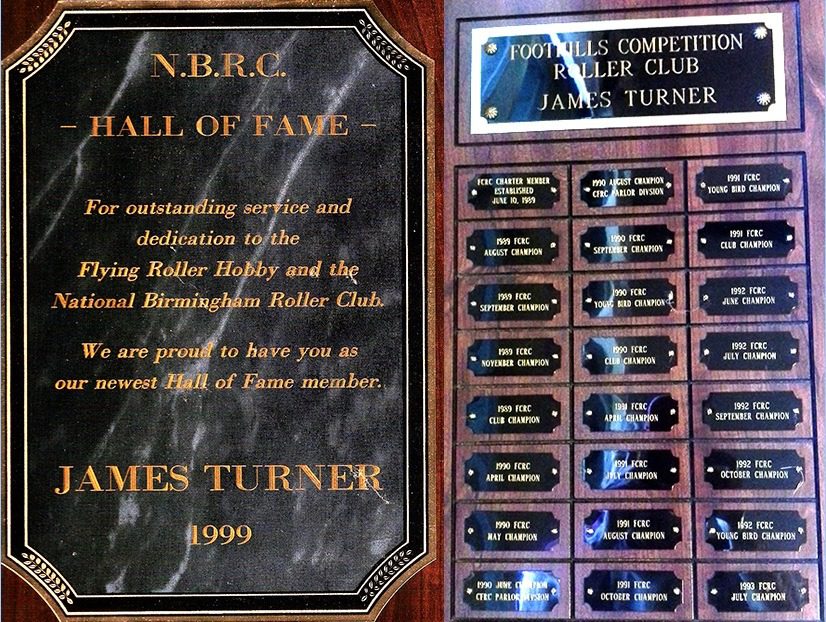
James Turner, of Greenwood, South Carolina, purchased his first two pairs of rollers in 1960. One of the pair threw a yellow self, a bird that performed so well and was so beautiful to James that an idea began to form in his mind that would eventually change the face of the Birmingham Roller forever. For it can be said with great confidence that William H. Pensom put the spin in the Birmingham Roller, but James Turner put color into that spin.
This is a bold statement, and one that is likely to draw fire from a few roller men; but I know of no one who has dedicated his life any more to the hobby, its organizations, and to the improvement of the performing roller. Joe Bob Stuka, himself a veteran breeder, trainer, competitor, and international judge, said this of James Turner, “James Turner is the most consummate roller man I have ever known and is the closest to what my impression of what Bill Pensom would have been like, in his standards of quality and ability to train and breed at a level only a few can come close to…”
It has been said of Pensom that he knew good rollers and he flew good rollers. He raised good rollers and he made good rollers available, to others. If ever there was another who approaches this same level of commitment and expertise, it is that of James Turner. “James has given away more real quality birds than anyone I know of,” said Don Simpson, a friend, competitor, and colleague in the sport. “Whenever James speaks, other breeders listen,” he added.
Clay Hoyle remembers when he, himself, was new in the sport. “I asked him many questions when I was learning and he could always help me with the answer.” This living legend is renowned, not only in his native South Carolina, but his reputation and the quality of the performance of his family of rollers extends throughout the USA, to neighboring countries; indeed, spanning the globe.
Simply put, he is known the world over as a cultivator of first-class rollers. Joe Stuka’s praise went further, “…Producing and flying the best pigeons in the world was not a big enough challenge for James… purely breeding for spin was not enough challenge… That’s what, I think, drove James to do a lot of color breeding… and he never stopped until he perfected it and had the best.”NBRC Publishing Editor, Bob Simpson, in 1992, paid tribute to Turner on the cover of an issue of Backspin, a regional roller publication, with the words, “It is his performance, and not just that of his birds, that separates James Turner from others and makes him truly outstanding.”
His accomplishments are numerous and impressive and demonstrate his expertise in the loft as well as many other aspects of the sport and hobby as a promoter of the roller pigeon and of fellowship among roller men. His feats speak for themselves and have placed him and his family of rollers in a class all their own. Turner has been highly regarded in every faction of the roller hobby as the ultimate team player, as well as an accomplished solo artist. In the early eighties, the NBRC was focused on promoting the performing roller only (as opposed to show rollers), the effort being led by George Valiska. The new “all fly” format of the club was eagerly accepted by James Turner. As NBRC conventions and competitions began to spring up in Louisville, Kentucky, Los Angeles, California, and eventually Dallas-Ft. Worth, Texas, James was instrumental in organizing regional conventions and competitions in South Carolina.
He engineered the first Southern Roller Classic in 1989, the convention standard for all others since, and organized three successive Southern Performing and Backspin Roller Classics, which were surpassed by none. He was one of the founding parties of the Foothills Competition Roller Club (FCRC) on June 10, 1989.
The Backspin Roller Classic, in its inaugural meeting, hosted some eighty fanciers from New York to New Mexico. The following year, 1990, it saw over a hundred fanciers in attendance from coast to coast; Canada, England, and Holland, and hosted the NBRC National Convention.
Throughout his 1990-1994 tenure as FCRC Secretary, James was co-editor of the aforementioned Backspin roller publication, a publication dedicated to promoting the Birmingham Roller Pigeon and fellowship among its fanciers in two great southern flying clubs, the Foothills Competition Roller Club and the Carolina Flying Roller Club (CFRC). In 1994, James was the FCRC Young Bird Champion and also held the Club Championship as a co-champion with Don Greene in that same year. At the same time, in 1993 and 1994, James served as NBRC Vice-president and judged the annual fly of the Triad Roller Club in North Carolina. In 1997, Turner was elected to be President of our national association, the NBRC, and the following year, 1998, he was NBRC Director-at-large.
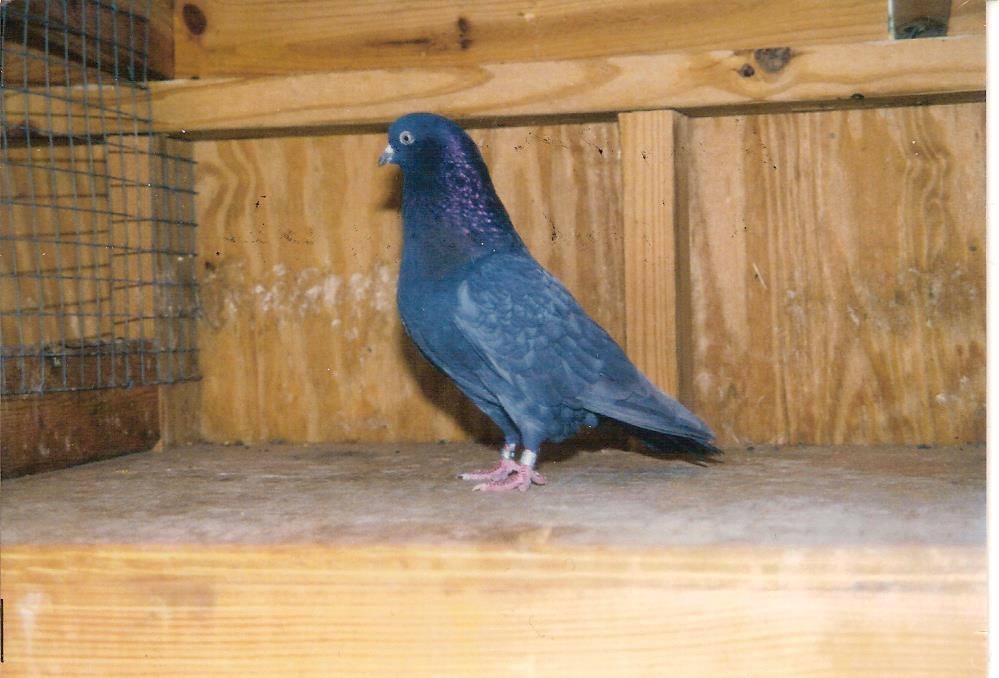
“How did you go about adding color to spin?” I asked Turner. “When one understands what to look for, one considers type, expression and breeding, plus aerial performance.” This Pensom quote goes to the heart of the philosophy of Turner’s breeding program. A knowledge of the exclusive qualities of good birds and the inheritance of the roll enabled James to select and breed better birds, when he wanted to incorporate a particular color modifier into the genetic makeup of the bird.
He has written a number of articles for publication on topics related to rollers, competed and judged in competitions too numerous to list, and traveled the United States in most of the states east of the Mississippi promoting the breeding of quality in the performance roller. James is also a lifetime member of the NBRC and a distinguished member of the NBRC Hall of Fame. In 1990 and 1992, Turner collaborated with Tony Roberts and produced a series of two videotapes on pigeon genetics. For the first time, the mysteries of genetics and color breeding were revealed, so that every breeder could gain the valuable insights that were often difficult to comprehend from a book or chart. In all his endeavors, James often carried more than his share of the weight to assure that these events and projects went smoothly and offered maximum enjoyment and potential for learning for his fellow roller men.
“In order to breed the best color roller, all I had to do was to mate those birds that performed in the air, that had the right type, as well as the right color modifier that I was looking for,” explains Turner. James Turner found himself living and validating many of Pensom’s philosophies over and over again, “Pensom was so right when he said, ‘It was an uphill battle because breeding always tends to revert back. This, in my opinion, is why pedigree is of no material value in any loft except to relate relationship.’ My original Thompson and Pensom birds gave me the genes for quality, speed, depth and frequency. Then I began to look around for other rollers with the genes for the color modifiers that I wanted,” Turner volunteered. The source of the competition spin of Turner’s family of rollers was Ed Garrett, of North Carolina, and Bob Welbourne of Greenville, South Carolina. Garrett brought in Lloyd Thompson (of British Columbia) bloodlines; Bob Welbourne brought in original Pensom stock. Out of the Thompson birds was bred a black white flight cock (929) and a blue check self hen.
Out of the Welbourne birds was bred a black white flight with mixed tail cock (6878) and a tort hen. Both 929 and 6878 were actually owned by Don Greene. Don loaned James both 929 and 6878. James late bought 929 from Don, but Don refused to accept payment for the bird. James refused to take the bird for free so he gave Don’s young daughter $50.00 for the bird! This kind of behavior by these two men, truly exemplifies the “southern gentlemen” they were known to be. These four rollers from the Garrett and Thompson lines were the foundation birds for James’ family. These birds were first-class spinners, though long cast and 1/3 again larger than his family today. (One of James’ objectives was a smaller cobby type that he produced through consistent line breeding.) James raised about ten young birds from 6878.
Of the progeny, nine were rolldowns, but one was deep and fast, and stable, just what he was looking for. Turner’s famous Rambo (9649) champion bloodline was the son of the Thompson pair, and was in tremendous demand by everyone who flew rollers at the time. “I couldn’t raise enough Rambo birds to even begin to fill the demand,” remarked Turner.
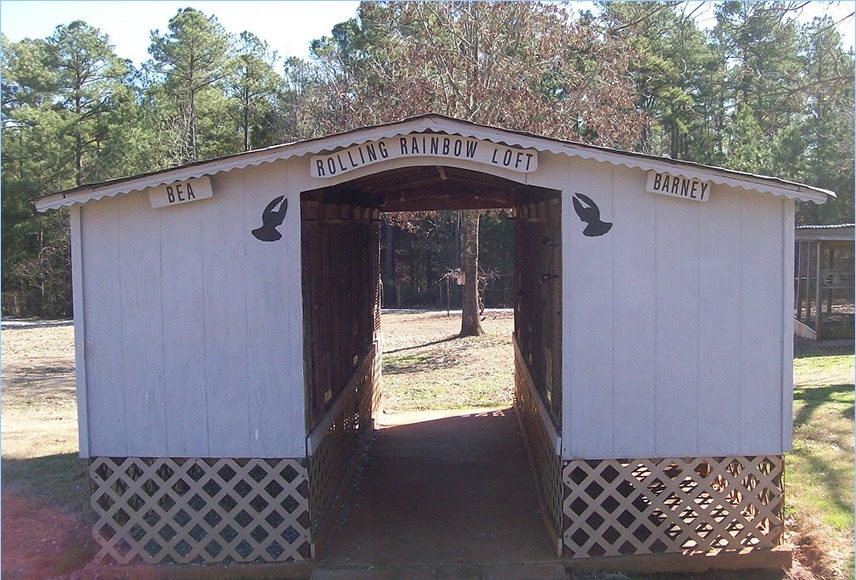
From his nationally acclaimed “Rolling Rainbow Lofts,” Turner embarked on a program that produced champion kits that featured color birds that could spin with the best of them. His greater objective in breeding was demonstrated through a sign that hung quietly beside the entrance to his breeding quarters, but spoke loudly of his intention: “Velocity, Control, Frequency, Depth.” It was not meant to intimidate or impress others, according to Turner, but to remind himself daily of the primary goals that he was striving to accomplish. It was all too tempting, at times, to lose that focus in the face of a beautifully-feathered roller that had to be culled because its performance did not meet his standards. When you see a kit of his family in the air, you will see that action speaks louder than the words on that sign. “The man was not impressed with mediocrity regardless of color or pattern,” Dominic Cirri, an experienced roller man from Maryland says of James.
Jay Yandle, who won the NBRC Fall Fly in 2003 with a kit of birds that he raised and trained from pairs that were loaned to him by James Turner, said of Turner’s family of birds, “The best kit of birds that I ever saw, was a kit of James Turner’s, in a regional fly, being judged by Dominic Cirri of Maryland. It was raining so hard that we had to shout to hear each other, yet in that driving rain, the frequency, depth, and speed of the performance of those rollers on that day, has yet to be matched by any that I have seen since.” This sentiment was echoed by the judge, Dom Cirri. “It was the 2002 Southeastern Roller Association’s Regional Fly. The 11-bird kit flown by James Turner was, to this day, the best I’ve ever viewed. The kit had it all; speed, depth, frequency, and style. It was as if the intensity of the rain was fueling the kit!” The kit went on to win the overall competition in the finals.
Dom Cirri likes to tell of his favorite comments from Turner, “He was once asked what he liked in the way of eyes in his family of birds. ‘I have two requirements,’ said Turner, ‘…that they have two of them, and that they have one on each side of their head!’ Investigating Turner’s opinion of type, a fellow roller man asked Turner, ‘What does the best roller look like?’ Turner formed a baseball-sized circle with his thumbs and index fingers and stated, ‘This big… for thirty feet!'” Cirri chuckled in recalling. Turner’s longtime friend and colleague in the sport, Don Greene, also of South Carolina, said of their family, “There were two years in the 90’s when James’ birds were never beaten in regional or local competitions. I thought I was doing great when I had one year like that!” Both Turner and Greene were three-time Regional Champs in World Cup competitions flying the same family of birds.
We have established that this family of birds was capable of top performance for a period of time that spans a couple of decades; not only in the beginning, but during the color projects of the 80’s and 90’s and, in fact, still today. Jay Yandle won the NBRC Fall Fly with this family of birds in 2003, as already mentioned. Double factor Indigo birds and Andalusians were among the Carl Hardesty family of birds flown by Joe Roe in his World Cup winning kit in 1993. But, let’s look more closely at the method used by Turner to put color into that spin. Working together, at times, with Tony Roberts, over the years, Turner began to search out rollers that possessed genes for specific color modifiers; one at a time. The Brown and Barless gene came from a hen obtained from the Young Bird Roller Show held at Louisville, Kentucky.
The Reduced gene came from Ellis McDonald of Dover, Alabama, and Frank Dallas (which produced the better spinners, and so became the true source of the gene in the family). The Faded gene came from Larry Schlattmann of Kentucky. The Indigo/Andalusian gene came from Bob Bettis of Ohio. Most other color modifiers came from a breeder who was a master at pigeon genetics at the time, Dal Stone of Los Angeles, California. In his search for rollers that possessed certain color modifiers with the right type and performance to meet his standards, James once embarked on a plan to create his own. Two “side projects” were developed apart from his main family line. In one he outcrossed an Ice Pigeon to a roller; in the other, an Archangel. However, the resulting progeny were so far away from the type of bird that he was looking for that he culled the whole lot.
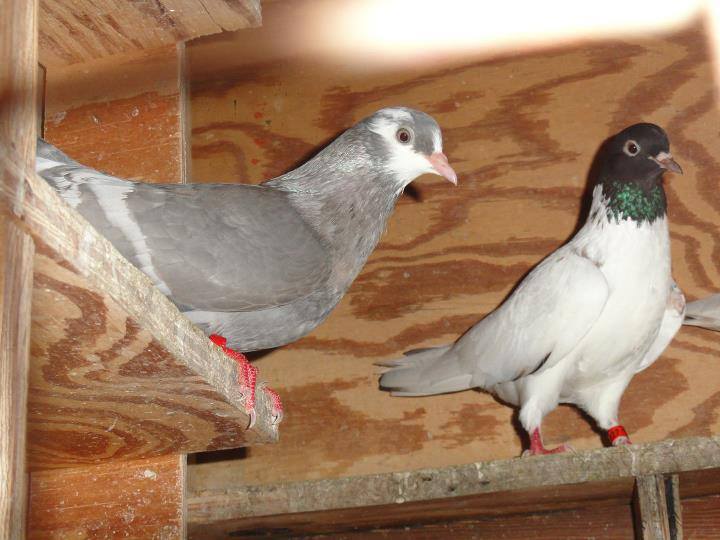
“I knew that there were not enough years left in my life to breed the numbers of generations that it would take to produce rollers of the right type and performance,” James remarked. He added, “There is absolutely no blood in any of my family of birds from those two side projects or from those birds.” After that, he concentrated on improving on the work already begun by other roller men and used only rollers that already possessed the certain gene for a color modifier that he wanted. In some cases the source of the gene had already been a work in progress for fifteen or twenty years. This allowed Turner to be more selective in order to find birds with the right type and expression to provide the color modifiers for his spinning birds.
So basically, the process consisted of breeding the roller with the color modifier already in place in its genetic makeup, to his fastest, deepest, and most frequent rollers of the type he desired; in other words, his best. He raised a dozen or so birds, as many as it took to produce one bird that had what he was looking for in type and performance in a spinning roller. He selected only one bird, the best, and all the rest, including the original source of the gene, were culled (or returned) and not randomly inserted into the breeding program. He then bred that one bird from the outcross back to the best performing parent, and through continued line breeding, best to best, until he was pleased with the final result.
Thus, he was able to produce color birds with speed, depth, frequency and style. It took a minimum of five years of breeding and flying out the young birds before a particular roller would meet his strict standards. “It took eleven years to get my first really good Dominant Opal,” Turner remarked to me. Over many years, a number of color genes were added and ultimately incorporated into this family in the same way; Almond and some its alleles (Qualmond and Faded), Indigo and Andalusian (two of the most successful and prolific lines), Reduced and Blue Lace, Dominant and Recessive Opal, Pencil, and Toy Stencil. Toy Stencil remains the most difficult, since multiple factors are at play, and is still a work in progress in Tony Robert’s and other lofts around the country.
Far outweighing the championship qualities of his family of birds, however, are the things that have, too often, gone unnoticed or fully appreciated. It has been his personal performance,and not that of his birds, that separates him from the average roller man and makes him truly outstanding. Pensom believed, “If somebody can come up with any theory which will convince the fancy, by clear and concise statements that cannot be disputed in opposition to this belief, then they can be assured of having done some good for everybody.”
James Turner’s life in the roller hobby has been dedicated, with sincerity and modesty, to the proposition that color modifiers could be added to the spinning performing roller, and the successful accomplishment of that goal is the legacy he leaves the hobby. And you may quote me on that! A word often used by James Turner is “integrity.” Nobody has a more rigid adherence to a code of conduct or standard of values than James Turner, himself. He simply is integrity. The charm of his smooth southern drawl and the grace of his gentlemanly manner have made him a favorite of all who have been fortunate enough to come to know him. No one individual has done more for our hobby any more proudly than this gentle giant of Greenwood, South Carolina, James Turner.
As with all great people who push the envelope of knowledge or think outside the box, Turner has his critics. “What these fellas need to do before they criticize me is get under a kit of my birds and then just look up!” says Turner. William Pensom also suffered the harsh inconsiderations of a few in the hobby. In attempting to understand this inherent flaw of human nature he concluded… “Knowledge should not be condemned until it is understood properly… It is a remarkable circumstance of human nature for the majority to sometimes be led by someone who is misinformed, but who is well-able to enforce loudly his objection on any subject entirely without rhyme or reason. Progress is all the more slow in any field because of these foolish in-considerations.”
But let it be known to all those who have not yet seen a kit of Turner’s award-winning family of birds in action, that the handwriting is, indeed, on the wall. There appear to be certain undeniable links between some color modifiers and factors (e.g. Recessive Red, Grizzle, Indigo, Andalusian) and quality in performance in the Birmingham Roller. Like Jay Yandle and Joe Roe that have won major national and World Cup competitions with these birds in their kits, many other competitors are including rollers with color modifiers in their competition kits and winning at all levels. James Turner’s contribution to the further understanding of the link between color and performance, as we attempt to fix certain desirable genetic traits for roll quality in our lofts, is equally undeniable.
– Let us hope and trust, as we all look up, and our eyes continue to be treated to these quality, deep spinning, high velocity kits of birds in beautiful rainbows of color that, one day soon, without any fear of discrimination whatsoever based on color, the breeder and trainer of the kit will feel the full freedom to express his pride in saying, “Those are James Turner birds.”I would like to acknowledge and thank the following contributors to the information contained in this article; Clay Hoyle, Bob Simpson, Don Greene, Joe Bob Stuka, Jay Yandle, Dominic Cirri, Wendall Carter, and the Backspin roller publication.- Cliff Ball lsdpri
